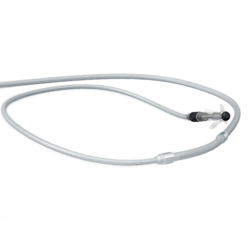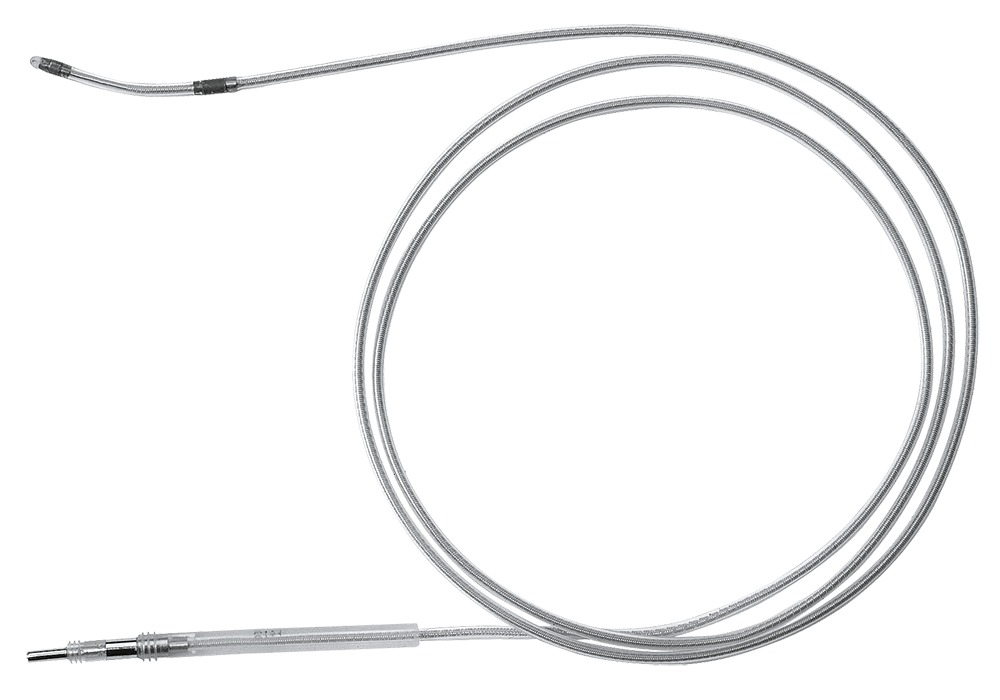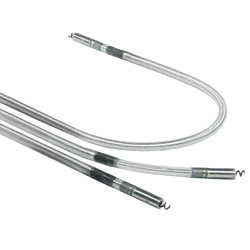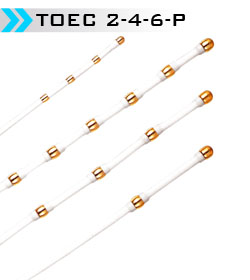 Single Leads Series
Single Leads Series
 Conary Sinus Leads
Conary Sinus Leads
 Atrial and Ventricular Leads
Atrial and Ventricular Leads
 Screw-in pacing leads
Screw-in pacing leads
 Transesophageal Leads
Transesophageal Leads
 Single Leads Series
Single Leads Series
![]()
Single Leads for VDD pacing with 3 cm long dipole that has always been the main feature of the MEDICO system
PHYMOS 44 MRI – MRI Tetrapolar single lead

Optimal floating atrial sensing thanks to the exclusive 30 mm dipole
Atrial electrodes in platinum – iridium
High fluoroscopic visibility
Small diameter, compatible with 8 Fr introducers
PHYMOS 44 MRI model allows to perform an effective VDD pacing with floating atrial electrodes, thanks to the 3 cm dipole which from the beginning characterizes MEDICO system: it guarantees an excellent reliability of the detection of sino-atrial node, also in the long-term.
PHYMOS 44 MRI is compatible with a 8 Fr introducer and is easily handled on implant, with easy and effective positioning. The material of the atrial electrodes is Pt-Ir whereas ventricular electrodes is microporous Ti coated by Pt. They allow satisfactory performance both in pacing and sensing, in addition an high visibility in scopy.
Technical features
- Atrial electrode material: platinum-iridium
- Ventricular electrodes material: Microporous titanium coated by platinum
- Sheath material: silicone, medical grade
- Distance between atrial dipole and ventricular electrode: 13 and 15 cm
- Atrial dipole length: 30 mm
- Length: 58 cm
- Atrial and ventricular connection: IS-1 bipolar
- Suggested introducer: 8 Fr
| PHYMOS 44 MRI | PHYMOS 44L MRI | |
|---|---|---|
| TOTAL LENGHT | 58 cm | 58 cm |
| DISTACE VD-AD | 13 cm | 15 cm |
Learn more about:
 Conary Sinus Leads
Conary Sinus Leads
![]()
Bipolar leads for left ventricle stimulation over the wire.
 Lifeline – Bipolar coronary sinus lead
Lifeline – Bipolar coronary sinus lead
 BIPOLAR CORONARY SINUS LEAD DESIGNED FOR PERMANENT PACING AND SENSING OF THE LEFT VENTRICLE.
BIPOLAR CORONARY SINUS LEAD DESIGNED FOR PERMANENT PACING AND SENSING OF THE LEFT VENTRICLE.
The model is available with 5 different curvatures according to the patient’s anatomy.
The availability of two different distances between electrodes (2 and 4 cm) makes ideal this lead for every implant indication of biventricular pacemaker.
In case of dilated cardiomyophaties, 4 cm dipole guarantees a simultaneous activation of a large area of the cardiac muscle, improving resynchronization therapy’s effects.
Thanks to perforation on tip electrode, the positioning in chosen coronary vein could be done using a metallic guide with the technique over the wire.
The chosen position stability is possible thanks to a special shaped track between two electrodes.
Technical features
- Electrode material: titanium coated by microporous platinum
- Sheath material: polyurethane, medical grade
- Interelectrode distance: 2 and 4 cm
- Length: 78 cm
- Connector: IS-1 bipolar
- Suggested introducer: 6 Fr
 Atrial and Ventricular Leads
Atrial and Ventricular Leads
![]()
Monopolar and bipolar leads, active or passive fixation , in silicone.
400 MRI – Ventricular bipolar pacing lead
 Passive fixation bipolar pacing lead used for ventricular implants.
Passive fixation bipolar pacing lead used for ventricular implants.
The electrodes, manufactured in microporous titanium coated by platinum, provides a good intrinsic signal detection and a reduced pacing energy.
Handiness and reliability, features which are always presents in all leads manufactured by Medico S.r.l. are present also in 400 model.
Technical features
- Electrode material: titanium coated by microporous platinum
- Sheath material: silicone, medical grade
- Total length: 58 cm
- Connection: IS-1 bipolar
- Suggested introducer: 7 Fr
400J MRI – “J” shaped atrial bipolar pacing lead
Passive fixation “J” shaped bipolar pacing lead used for atrial implants.
The electrodes, manufactured in microporous titanium coated by platinum, provides a good intrinsic signal detection and a reduced pacing energy.
Handiness and reliability, features which are always presents in all leads manufactured by Medico S.r.l. are present also in 400J model
Technical features
- Electrode material: titanium coated by microporous platinum
- Sheath material: silicone, medical grade
- Total length: 53 cm
- “J” shaped
- Connection: IS-1 bipolar
- Suggested introducer: 7 Fr
 Screw-in pacing lead
Screw-in pacing lead
![]()
Screw-in pacing lead with conducting retractable screw.
VITIS – Catetere screw-in

Securing your care in lead implantation.
Screw-in pacing lead with conducting retractable screw.
Technical features
- External insulation: silicone, medical grade / polyurethane
- Helix material Platinum – Iridium coated with microporous Platinum
- Fixation Active extendable / retractable helical screw
- Helix external diameter 1,20 mm
- Atrial e ventricular connection: IS-1 bipolar
- Suggested introducer: 7 Fr
Models available
| VITIS A | VITIS AS | VITIS V | VITIS VS | |
|---|---|---|---|---|
| LENGTH | 52 cm | 52 cm | 55 cm | 58 cm |
| INTERELECTRODE DISTANCE | 13 mm | 13 mm | 13 mm | 13 mm |
| STYLETS LENGTH | 54cm / 56cm “J” shaped | 54cm / 54cm “J” shaped | 57 cm | 60 cm |
| STYLETS THICKNESS AND SHAPE OPTIONS | 1×0.35mm 2×0.35mm “J” shaped | 1×0.35mm / 1×0.40mm 1×0.35mm preformato a J | 2×0.35mm / 1×0.40mm | 2×0.35mm / 1×0.40mm |
| EXTERNAL INSULATION | Polyurethane | Silicone medical grade | Polyurethane | Silicone medical grade |
| HELIX LENGHT | 1,8 mm | 1,6 mm | 1,8 mm | 1,6 mm |
| HELIX AREA | 4,5 mm2 | 4,1 mm2 | 4,5 mm2 | 4,1 mm2 |
 Transesophageal Leads
Transesophageal Leads
![]()
TOEC leads for transesophageal stimulation are made up of golden plates brass electrodes, placed at fixed distance. They can be introduced oral or rhinopharyngal approach, the sheath material is radium-opaque, which permits easily the positioning under X-ray control.
 TOEC 4 (tetrapolar)
TOEC 4 (tetrapolar)
Lead for transesophageal cardiac stimulation. The wide surface electrodes are made of golden brass, with interelectrode distance of 23 mm, which allow to decrease the energy density emitted on the contact surface, thus avoiding the inconveniences that sometimes occur during this procedure. The sheath material is made of silicone and is radium-opaque, for a better visibility under x-scopy. The tip is not traumatic and conform to the anatomy of the oesophagus, to avoid troubles and possible injuries during the positioning.
 TOEC 2 (bipolar)
TOEC 2 (bipolar)
Lead for transesophageal cardiac stimulation. The wide surface electrodes are made of golden brass, with interelectrode distance of 30 mm, which allow to decrease the energy density emitted on the contact surface, thus avoiding the inconveniences that sometimes occur during this procedure. The sheath material is made of silicone and is radium-opaque, for a better visibility under x-scopy. The tip is not traumatic and conform to the anatomy of the oesophagus, to avoid troubles and possible injuries during the positioning.
 TOEC 6 (esapolar)
TOEC 6 (esapolar)
Lead for transesophageal cardiac stimulation. The wide surface electrodes are made of golden brass, with interelectrode distance of 15 mm, which allow to decrease the energy density emitted on the contact surface, thus avoiding the inconveniences that sometimes occur during this procedure. The sheath material is made of silicone and is radium-opaque, for a better visibility under x-scopy. The tip is not traumatic and conform to the anatomy of the oesophagus, to avoid troubles and possible injuries during the positioning.
 TOEC P (pediatric tetrapolar)
TOEC P (pediatric tetrapolar)
Lead for pediatric transesophageal cardiac stimulation. The electrodes are made of golden brass, with interelectrode distance of 10 mm, with a surface area able to keep a low energy density, thus avoiding the inconveniences that sometimes occur during this procedure and at the same time with a good detection of endoesophageal signals, thanks to their special geometry. The sheath material is made of PVC and is radium-opaque, for a better visibility under x-scopy. The tip is not traumatic and conform to the anatomy of the oesophagus, to avoid troubles and possible injuries during the positioning.
![]() The products shown on this site are those currently in production. For more information or to get technical support on our products please CONTACT US >>
The products shown on this site are those currently in production. For more information or to get technical support on our products please CONTACT US >>
Products | Technology | Support | Contacts

